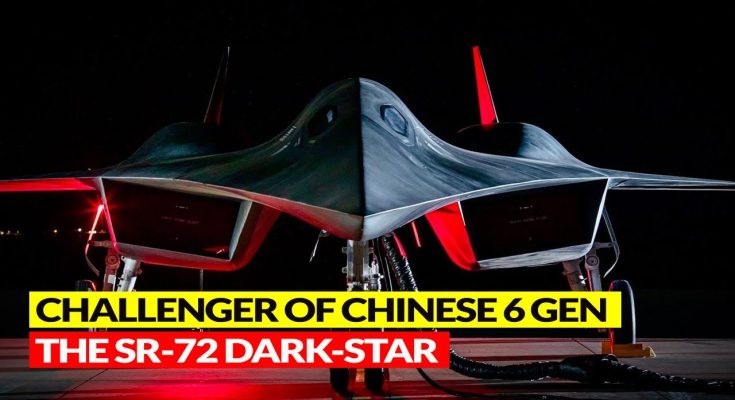Is This the Real Lockheed ‘SR-72 Darkstar’ Hypersonic Aircraft?
The name “SR-72 Darkstar” has sparked significant curiosity and speculation ever since it first surfaced, especially given its apparent ties to Lockheed Martin’s prestigious SR-71 Blackbird—a legendary aircraft renowned for its speed, altitude, and reconnaissance capabilities. For years, aviation enthusiasts and military insiders have wondered whether the SR-72 Darkstar would become the next major leap in aviation technology, pushing the boundaries of hypersonic flight. But is the SR-72 Darkstar really a hypersonic aircraft in development, or is it simply the stuff of legend and concept drawings?
The SR-71 Legacy and the Hypersonic Dream
The SR-71 Blackbird, which served from the 1960s through the 1990s, was a groundbreaking aircraft that captured the imagination of aviation enthusiasts due to its top speed of over Mach 3 and its high-altitude capabilities. Despite its decommissioning, the SR-71 continues to be regarded as one of the most extraordinary aircraft ever built, and many people have speculated about a successor to this iconic plane.
Enter the SR-72 Darkstar. According to Lockheed Martin, the SR-72 would be a hypersonic aircraft capable of traveling at speeds over Mach 6 (six times the speed of sound) and performing reconnaissance or strike missions. Hypersonic flight, which is defined as speeds greater than Mach 5, has long been a dream of aerospace engineers, but it has been incredibly difficult to achieve due to the extreme heat and aerodynamic stresses involved.
The SR-72, first mentioned publicly by Lockheed in the 2000s, would represent a monumental leap forward in technology, as it would be capable of performing missions far beyond the capabilities of any current aircraft. The hypersonic speed would allow it to strike targets or gather intelligence with unprecedented speed and agility, making it a formidable tool in both military and intelligence-gathering operations.
The SR-72 Darkstar – Fact or Fiction?
Lockheed Martin’s SR-72 Darkstar has become the subject of much speculation and interest, particularly in the wake of its appearance in the 2022 movie Top Gun: Maverick, where a fictionalized version of the aircraft makes an appearance. However, while this cinematic portrayal stoked the flames of curiosity, the real question remains: is the SR-72 Darkstar an operational aircraft in development, or just another futuristic concept?
In reality, while Lockheed Martin has acknowledged work on hypersonic technologies, concrete details about the SR-72 Darkstar remain scarce. The company has teased concepts, such as designs that utilize scramjet propulsion (a technology that allows an aircraft to sustain hypersonic speeds by compressing incoming air at extreme velocities), but it’s unclear whether the SR-72 Darkstar exists as a real, fully operational aircraft or if it’s still a concept that hasn’t left the drawing board.
It’s also worth noting that Lockheed Martin has been actively involved in developing other hypersonic projects, such as the X-51 Waverider, a test vehicle that achieved brief periods of hypersonic flight. This suggests that while the SR-72 may not be a fully realized aircraft yet, Lockheed Martin is certainly exploring the underlying technologies needed to make hypersonic flight a reality in the future.
Technological Hurdles and Timeline
The development of a true hypersonic aircraft like the SR-72 Darkstar faces numerous technological challenges. One of the main hurdles is heat management; at speeds greater than Mach 5, the friction between the aircraft and the atmosphere generates intense heat. Advanced materials and cooling systems would be required to prevent the aircraft from disintegrating in flight. Additionally, hypersonic flight demands an entirely new class of engines, as conventional jet engines can’t operate at such extreme speeds. This requires breakthroughs in propulsion systems, such as ramjets or scramjets, which are still being refined.
Furthermore, hypersonic aircraft need to be designed for stability and control at such extreme velocities, and creating maneuverable aircraft that can operate at Mach 6 and beyond is no easy feat.
Conclusion
While the SR-72 Darkstar has become synonymous with the idea of hypersonic flight and is closely associated with Lockheed Martin’s vision for the future of aviation, it’s unclear whether a real SR-72 exists beyond the realm of concept designs. The aircraft might represent a future goal rather than an actual program that is actively being developed, and much of the mystery surrounding the SR-72 could stem from the classified nature of military aerospace projects.
For now, the SR-72 Darkstar may remain more of a tantalizing idea than a tangible aircraft. That said, it is clear that the technologies needed for hypersonic flight are in development, and it is only a matter of time before hypersonic aircraft—whether the SR-72 or another project—become a reality. Whether the Darkstar is real or not, the work being done to achieve hypersonic speeds promises to reshape the future of aviation, military operations, and beyond.



